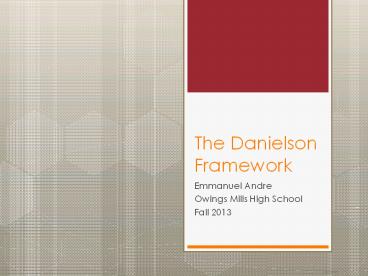The Danielson Framework - PowerPoint PPT Presentation
1 / 14
Title:
The Danielson Framework
Description:
Why is this happening? The Danielson Framework, as it is being implemented in BCPS, is intended to increase objectivity and consistency from school to school within ... – PowerPoint PPT presentation
Number of Views:97
Avg rating:3.0/5.0
Title: The Danielson Framework
1
The Danielson Framework
- Emmanuel Andre
- Owings Mills High School
- Fall 2013
2
Why is this happening?
- The Danielson Framework, as it is being
implemented in BCPS, is intended to increase
objectivity and consistency from school to school
within our system.
3
Why is this a good thing?
- Teaching is an extremely complex activity, this
framework is useful in laying out the various
areas of competence in which professional
teachers need to develop expertise.
(www.andrews.edu) - This means that it measure the WHOLE teacher,
not just the person that is seen 4 times a year.
It is a much more authentic reflection of what
you do every day.
4
What does it look like?
- - 4 Domains
- - 4 Tiers of
- Evaluation
- - Clear
- Expectations
5
Components
Workbook page 3
6
Performance Levels
In each domain, we will be rated as
- Then
- Now
- Unsatisfactory
- Satisfactory
- Ineffective
- Effective Developing
- Effective
- Highly Effective
7
How will this affect me?
- Qualitative 50
- Quantitative 50
- Performance in the 4 domains.
- Everything discussed so far.
- Student learning outcomes(SLOs)
- School progress index
- State testing data
8
Student Learning Outcomes (SLO)
- SLOs are a way to measure student growth by
establishing learning goals - Used for a wide variety of teaching assignments
- Adaptable
- Can measure individual, group or school
performance - Good instructional practice
9
Essential Components of SLOs
- Level of objective
- Student population included
- Timeframe for evaluating progress toward the
objective - Assessment used to measure progress
- Assessment baseline
- Expected student growth
- Strategies for achieving growth
10
School Index
- Achievement
- State testing results
- Gap
- Gap between lowest and highest subgroups
- Growth/College and Career Readiness
- Percent of students making one years
growth/Graduation Rate/Career Attainment/Attendanc
e
11
Formal Observations
- New Pre- Observation Tool
- New Post Observation Tool
- New Formal Observation Tool
- Aligned to Framework for Teaching
12
New Evaluation Cycle
- 3 year cycle
- 2 formative years
- Formal observation and informal observation data
- Professional Growth Plan evidence
- Rating from last summative year and narrative
- Student Learning Outcome evidence
- 1 summative year
- 3 years of Observation Evidence
- 3 years of Student Learning Outcome data
- School Performance Index data
- State Testing data
13
Activity
- In order to better understand the Qualitative
portion of the evaluation we will now take part
in an activity focused on the Formal Observation
Rubric. - If not already, split into 8 groups
- Open the envelope given to you
- Define the component in your own words
- Respond to the scenario as a teacher at every
level (Ineffective-Highly Effective) - Use the rubric to help you.
14
Gallery Walk
- Post your posters around the room
- Using the ½ sheets of paper take notes on the
traits of highly effective teachers vs. those of
ineffective teachers































